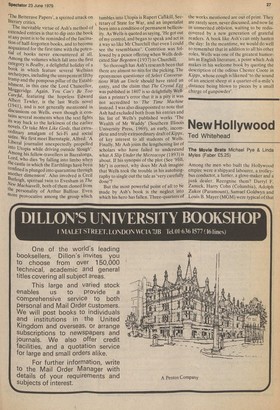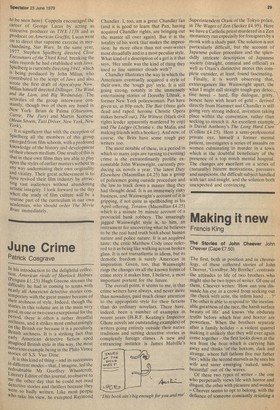New Hollywood
Ted Whitehead
The Movie Brats Michael Pye & Linda Myles (Faber £5.25)
Among the men who built the Hollywood empire were a shipyard labourer, a trolleybus conductor, a furrier, a glove-maker and a junk dealer. Recognise them? Darryl F. Zanuck, Harry Cohn (Columbia), Adolph Zukor (Paramount),. Samuel Goldwyn and Louis B. Mayer (MGM) were typical of that tough breed of entrepreneurs who settled on Hollywood 'because it had decent water and was close enough to the Mexican border if writs arrived'. They had their greatest success in 1946 when more people paid more money than ever before — or since — to go to the movies. But in the following 20 years the empire crumbled and the studios fell into the hands of a very different breed. Financial control passed to lawyers, accountants and salesmen, while creative control was inherited by a new generation of highly literate cineastes, 'the movie brats'.
Michael Pye of the Sunday Times and Linda Myles, director of the Edinburgh Film Festival, have written a fascinating account of the shifting patterns of power in the American film industry. In assessing the decline of the old studios, they consider the conventional explanation — the spread of television, and the court decisions compelling the major companies to sell their chains of theatres. But they argue convincingly that the fundamental reason was . demographic and even ideological. In the 1950s suburbia was growing 40 times as far as the inner city. And suburbia worshipped 'home, hearth, children and church'. People lost the habit of going to the pictures. Misreading the situation, the film moguls saw only the threat of television and, influenced by the success of The Sound of Music (`The worst thing that ever happened to this business' — Hitchcock) decided to compete with ever more spectacular and expensive films. The strategy was bound to fail because it was the cinema that was becoming redundant, not the film.
Then in the Sixties came the revival. First, there emerged a new market: the young, who were desperate to escape the precious clutches of home and family, and who liked nothing better than a night out in the back of the car with the beloved at a drive-in movie. And then changes in Internal Revenue law allowed investment in films to become a profitable tax-loss. The way was open for the new film-makers to reach the new audience.
Here the influence of the film schools was critical. By this time the three most distinguished schools, the University of Southern California, the University of California at Los Angeles, and New York University had produced a generation of graduates whose ambition was not to write the great American novel but to make the great American movie. What they needed was experience of the film industry, and this was provided, ironically, by a maker of exploitation movies, Roger Corman. Corman was quite willing to use non-union labour at low rates of pay to churn out low-budget shockers made at breakneck speed. It was exactly what the new graduates needed.
The Movie Brats studies in detail the careers of six of these new-wave directors. Francis Coppola was the first to make a full feature (Dementia 13, 1962) and became famous for the two parts of The Godfather, The Conversation and Apocalypse Now (yet to be seen here). Coppola encouraged the career of George Lucas by acting as executive producer on THX-1 138 and as producer on American Graffiti; Lucas went on to direct that supreme exercise in merchandising, Star Wars. In the same year, 1977, Stephen Spielberg directed Close Encounters of the Third Kind, breaking the sales records he had established with Jaws. Spielberg is currently directing 1941, which Is being produced by John Milius, who contributed to the script of Jaws and also wrote the first draft of Apocalypse Now. Milius himself directed Dillinger, The Wind and the Lion, and Big Wednesday. The activities of the group interweave constantly, though two, of them are based in New York: Brian de Palma (Obsession, Carrie, The Fury) and Martin Scorsese (Mean Streets, Taxi Driver, New York, New York).
It is significant that with the exception of Spielberg all the members of this group emerged from film schools, with a profound knowledge of the history and development Of their chosen medium. One result of this is that in their own films they are able to play Upon the styles of earlier masters without in any way undermining their own originality and vitality. Their great achievement is to have revived their film industry by attracting vast audiences without abandoning artistic integrity. I look forward to the day When the study of film culture will be a routine part of the curriculum in our own academies, who should order The Movie Brats immediately.












































 Previous page
Previous page